Cyrus Klepcys Vertical Tourbillon: ‘Artificial Gravity’ On The Wrist
What do you think of when you imagine a spacecraft with artificial gravity? Most sci-fi nerds probably think of either a large rotating ring or cylinder to simulate the forces of gravity via centripetal force or an imaginary “gravity field” generator magically creating gravity by some scientific-sounding jargon when special effects budgets don’t allow for animated spaceships.
Sarcasm aside, variations of these appear in pretty much every sci-fi space story because it is one of the biggest concerns when hypothesizing about life in space. Without some way for the actors to control themselves in a supposedly weightless environment, outer space fight scenes would be a bit less riveting. But depending on which method writers use, it can have a dramatic effect on the design of the spaceship.
While there are many varieties of fictional spacecraft and space stations utilizing centripetal force, there are three main variations.
The first is the large “ringworld” space station that is basically a very large ring with an earth-like habitat on the inner surface, much like you would see in the video game “Halo” or the book appropriately titled Ringworld by Larry Niven.
The second is the cylinder-type ship, which comprises a long cylinder rotating around an axis that is parallel to the direction of travel like the space colony in the anime “Gundam” or the Medina Station from the TV show The Expanse. The inside of the cylinders are made to have open air-style habitats that simulate life on a planetary surface, albeit smaller and sort of curved.
Both of those examples are better tailored to stationary space stations or generational (extremely long mission) spaceships. The third main variation is used make interplanetary or short interstellar trips (and attempt to seem technologically accurate).
These types have a shape that is best defined as a long, linear assembly of sections with one relatively small ring circling the main body, allowing for an area that astronauts can stay acclimated to gravity but doesn’t require the entire ship to be spinning.
This type is seen frequently, with examples including the Avalon in Passengers, the Hermes in The Martian, the Endurance in Interstellar, and the one that started it all, the Discovery One in 2001: A Space Odyssey.
The shape has become so normalized in sci-fi that it is what I first imagine when I think of a realistic interplanetary spaceship. That also means that I see things in everyday life that remind me of this concept and, as you may have guessed, some of those things are watches. One of the more recent examples is the astoundingly cool Cyrus Klepcys Vertical Tourbillon.

Cyrus Klepcys Vertical Tourbillon in red gold
The tourbillon, turned 90 degrees to the movement and in combination with dual crowns, creates a visual spectacle that, with a few tweaks, could easily translate into a passable spaceship with an artificial gravity ring in the center.
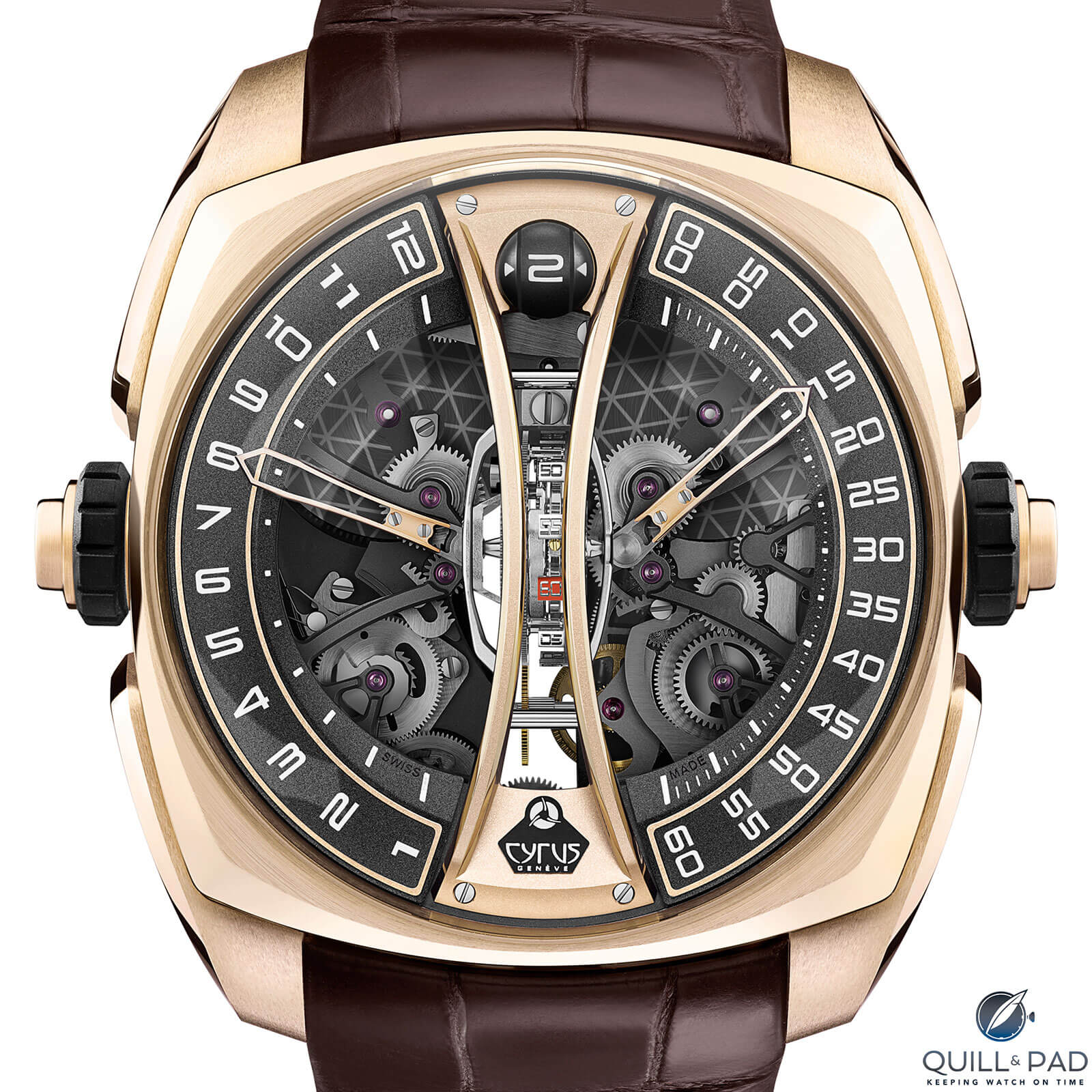
Cyrus Klepcys Vertical Tourbillon Skeleton
It makes more sense as a watch so I want to dig into the Klepcys Vertical Tourbillon and share just how awesome it is.
Cyrus Klepcys Vertical Tourbillon: futuristically inclined
Even before we get into the out-of-this-world style, I need to point out something important: the movement inside was engineered and created by none other than Jean-François Mojon and his Chronode, the man (and team) behind such modern masterpieces such as the HYT H1, Opus X from Harry Winston, Legacy Machine 1 by MB&F, and most recently the Hermès Arceau L’Heure de la Lune among others.
Thanks to a partnership between Cyrus and Chronode, Mojon and his company have been helping guide some awesome development this independent brand as well.
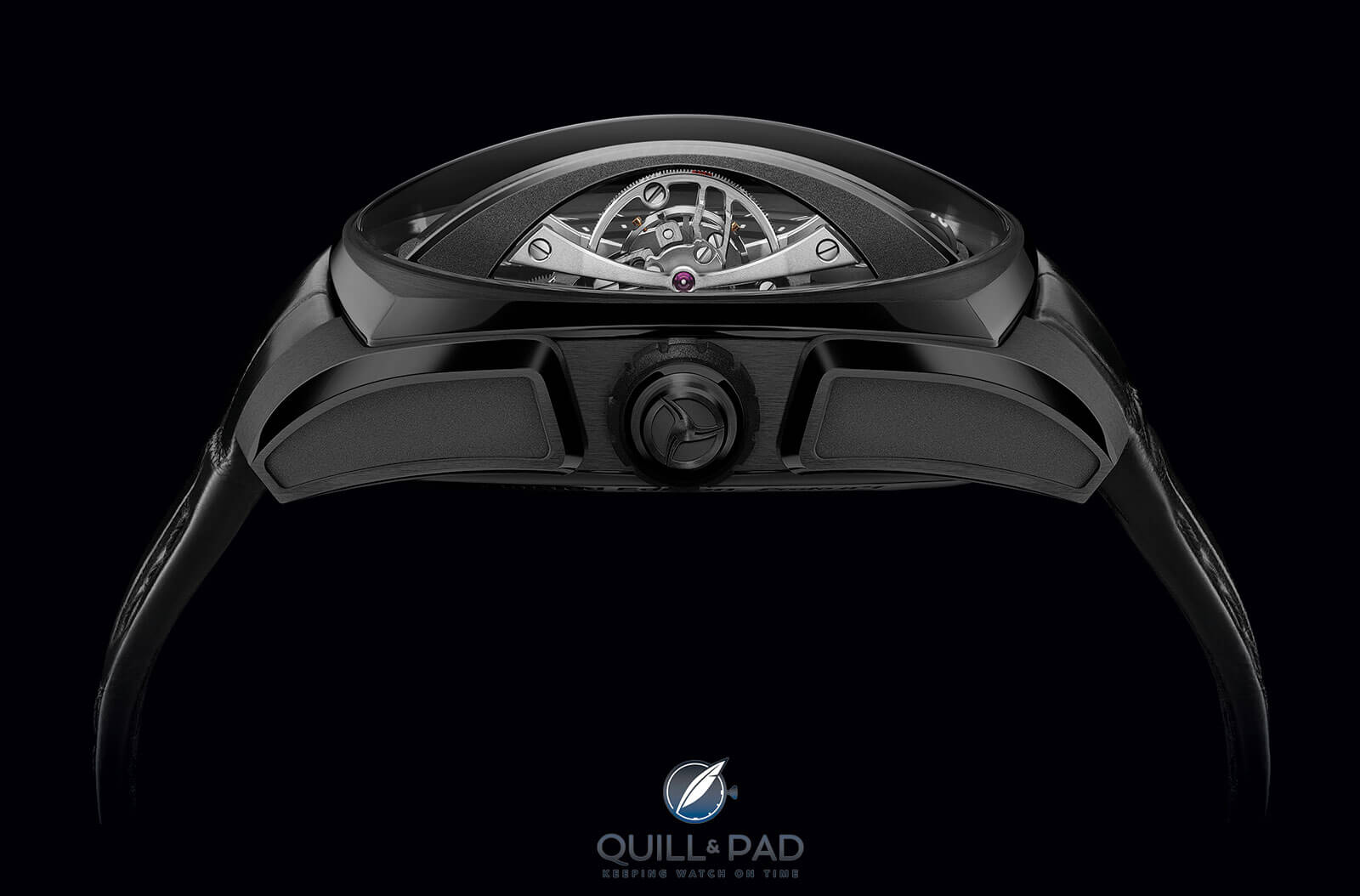
Surreal side-on view of the Cyrus Klepcys Vertical Tourbillon in DLC-coated titanium
The Klepcys Vertical Tourbillon (2018) and the Klepcys Vertical Tourbillon Skeleton (2019) are the most recent creations from this truly incredible collaboration. The entire concept centers around a vertically oriented tourbillon in the center of the movement rotating in a plane that runs from top to bottom.
The tourbillon, which displays the running seconds in increments of five on plates rotating from bottom to top, makes one rotation every minute. It is surrounded by a large arched bridge that spans the movement, helping to create a visual window for the tourbillon.
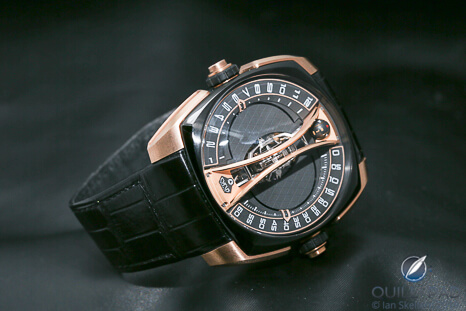
Cyrus Klepcys Vertical Tourbillon
The 100-hour power reserve indicator is at the top of the bridge assembly, its increments measuring days, showing “4” when fully wound.
The symmetry of the dial is continues with the separation of the retrograde hours and minutes. The hours are presented on the left, where the hour hand jumps every hour, slowly climbing up the dial to “12” before snapping back down to “1” twice a day.
The minutes on the right smoothly continue down the scale until they suddenly snap back to a double zero at the end of every hour. This return activates the hour mechanism to advance by one position; both are driven by snail cams, though the hour cam has 12 distinct positions to keep the hour hand pointing directly at the numeral at all times.
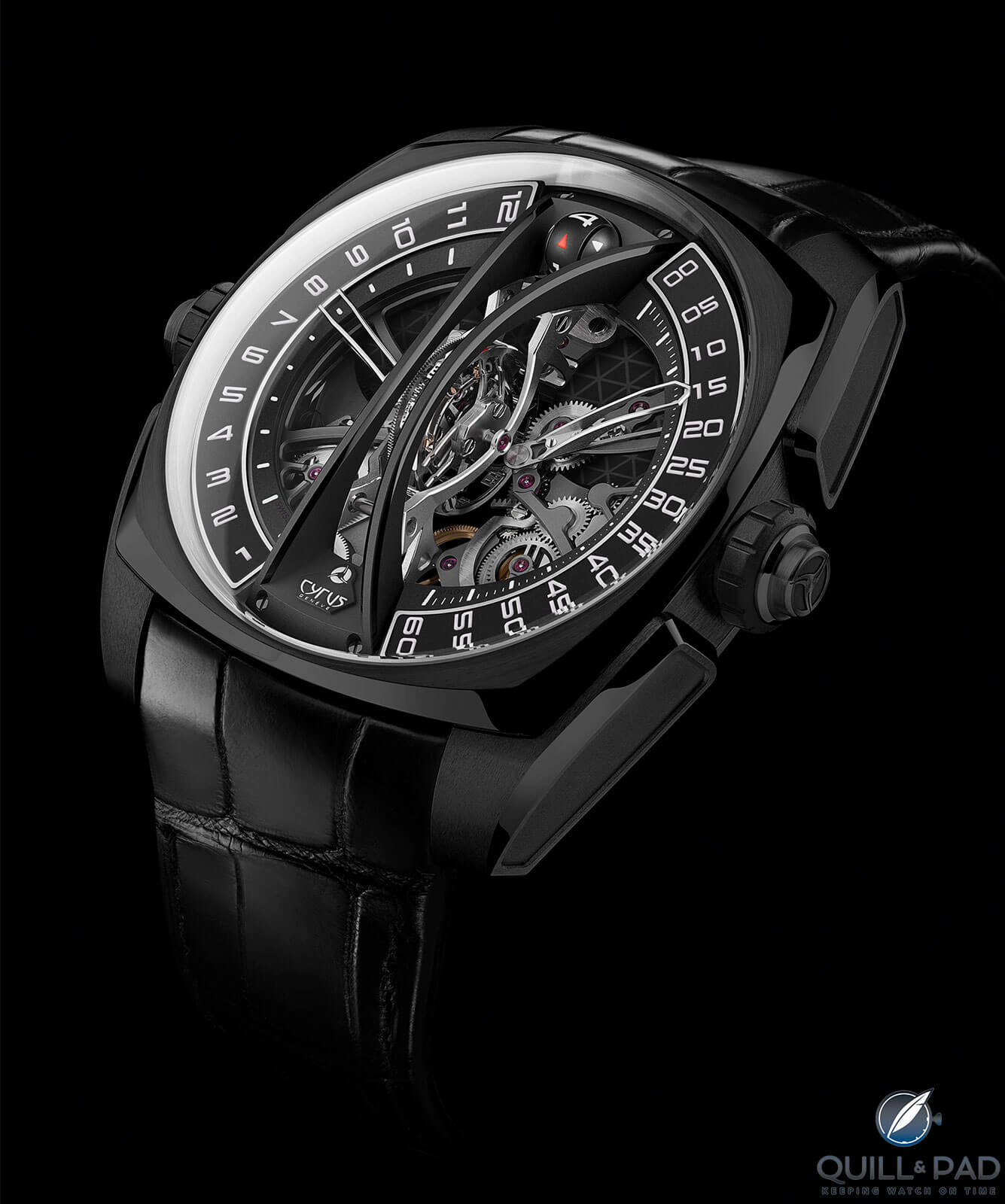
Cyrus Klepcys Vertical Tourbillon Skeleton in black DLC-coated titanium
All of this is operated via crowns on either side of the case, the one on the right responsible for winding and time setting, while the one on the left is actually a pusher for rapid hour setting (unusual travel watch, anyone?).
Cyrus Klepcys Vertical Tourbillon: design from mechanics
This mechanical ballet was hidden from view on the initial release models of 2018, but the skeletonized versions of 2019 have removed the engraved half-moon-shaped dial covers to expose the hard work and cleverness underneath.
As mentioned before, the retrograde function uses a snail cam mechanism regulated by a “bevel-style” gear to the bottom right of the tourbillon. It doesn’t have a bevel and it meshes with a fairly standard spur gear, so it reminds me more of a clock mechanism than a watch mechanism.
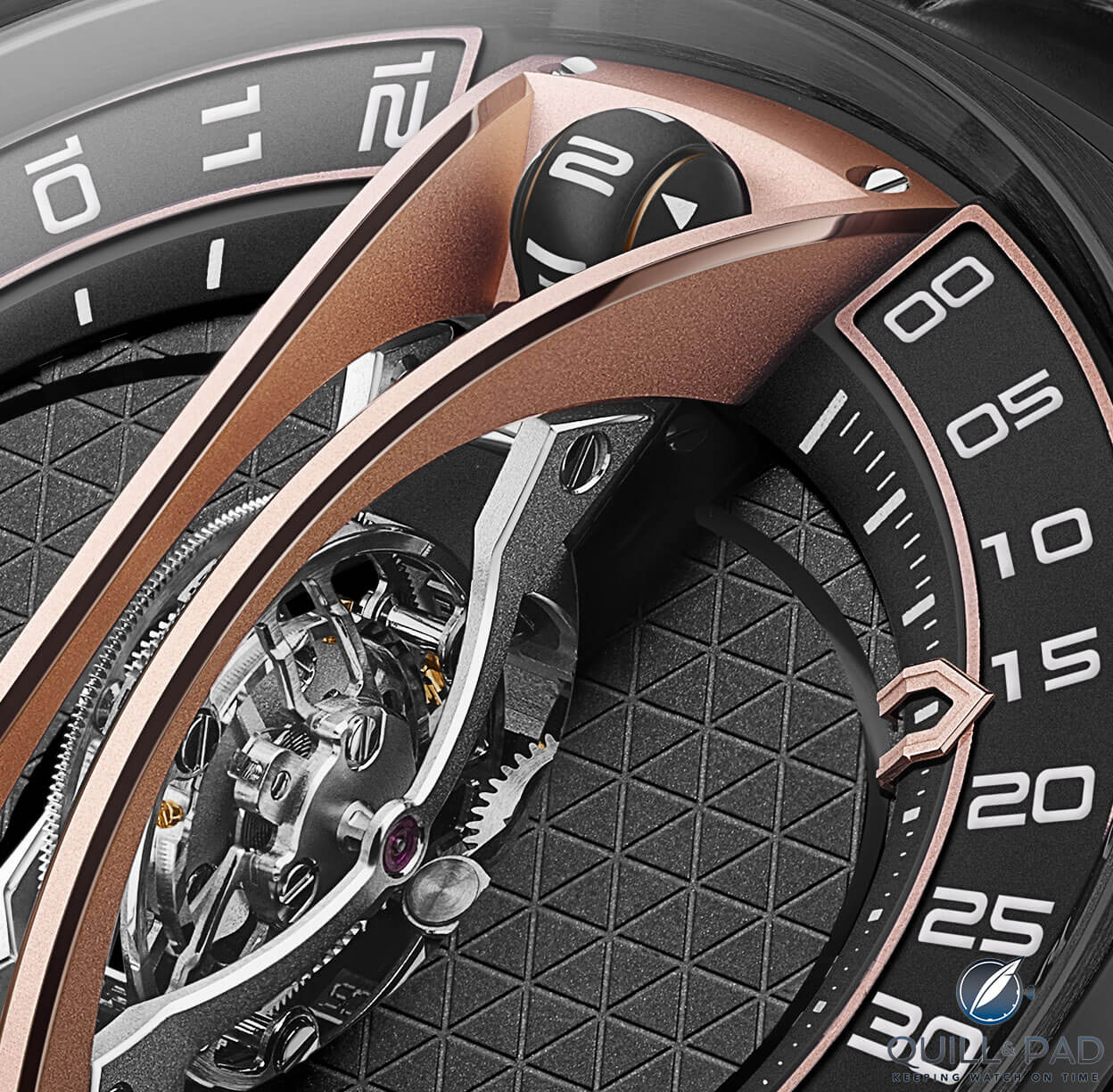
Cyrus Klepcys Vertical Tourbillon dial detail
Each retrograde mechanism uses its own idler gear with a spiral return spring mounted on top, much different than most with flat lever springs. The hands are driven by a spur gear that meshes with a sector gear machined into the cam-follower arms. The mechanism is relatively straightforward for a retrograde, but done very well to maintain symmetry.
The large bridge that surrounds the vertical tourbillon is an interesting design detail: the shape and structure is about creating a good visual as it doesn’t support the tourbillon cage at all. The large arches serve to frame the tourbillon and keep focus on the plates for the indication of seconds attached to the cage.
The actual support for the tourbillon cage is mounted to the main plate underneath the dial and comes up to meet the large arch. But they aren’t connected.
From a design standpoint, this is very clever as most people seeing this might not notice for a while that it is a completely non-functional aesthetic component.
The requirements for the Klepcys Vertical Tourbillon’s tourbillon bridges are much more constrained, and therefore it is much smarter to focus on engineering those to be functional while drawing attention to the bigger, more distinct shape right next to it.
The tourbillon bridges are still cool, nicely shaped arches themselves with polished spacers between to hold the tourbillon assembly in precise alignment before installing them in the movement.
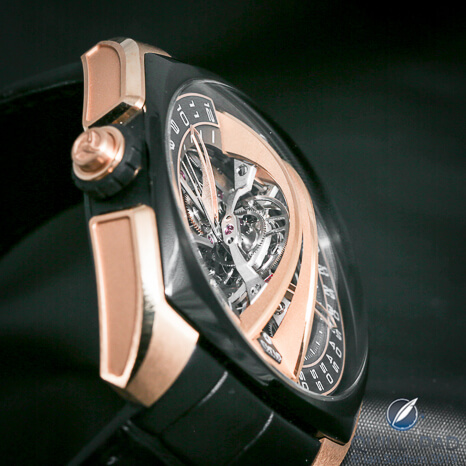
Cyrus Klepcys Vertical Tourbillon Skeleton
But that large arch is about architecture, engineering, and aesthetic. And it hits hard as it spans the entire movement.
At the top of the dial, between the arches, is the power reserve sphere, which despite the way it might seem is not a rotating sphere but instead a rotating cylinder (with a spherical curve) set between two aesthetic sphere ends to hide the axis of rotation and provide a non-moving surface for the application of indicating arrows. This way you get the look you want with a function that is more mechanically realistic.
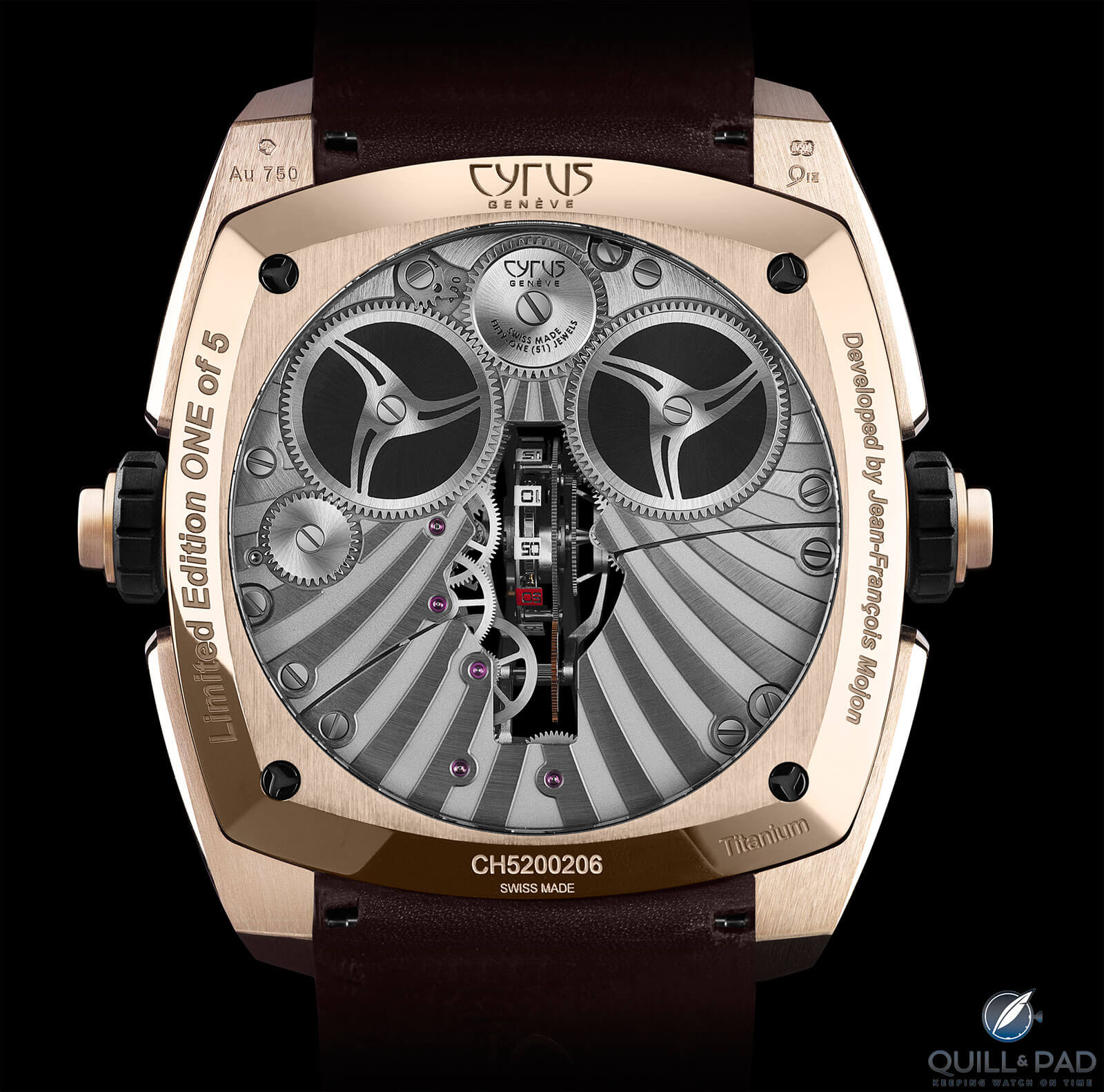
Back of the Cyrus Klepcys Vertical Tourbillon Skeleton
The function of the Klepcys Vertical Tourbillon is awesomazing for sure, and the aesthetic is bold and futuristic. I could even see in an alternate universe that this watch was created as a miniature tribute to some glorious space station at the edge of our solar system because it looks so much like some concept art from a sci-fi epic.
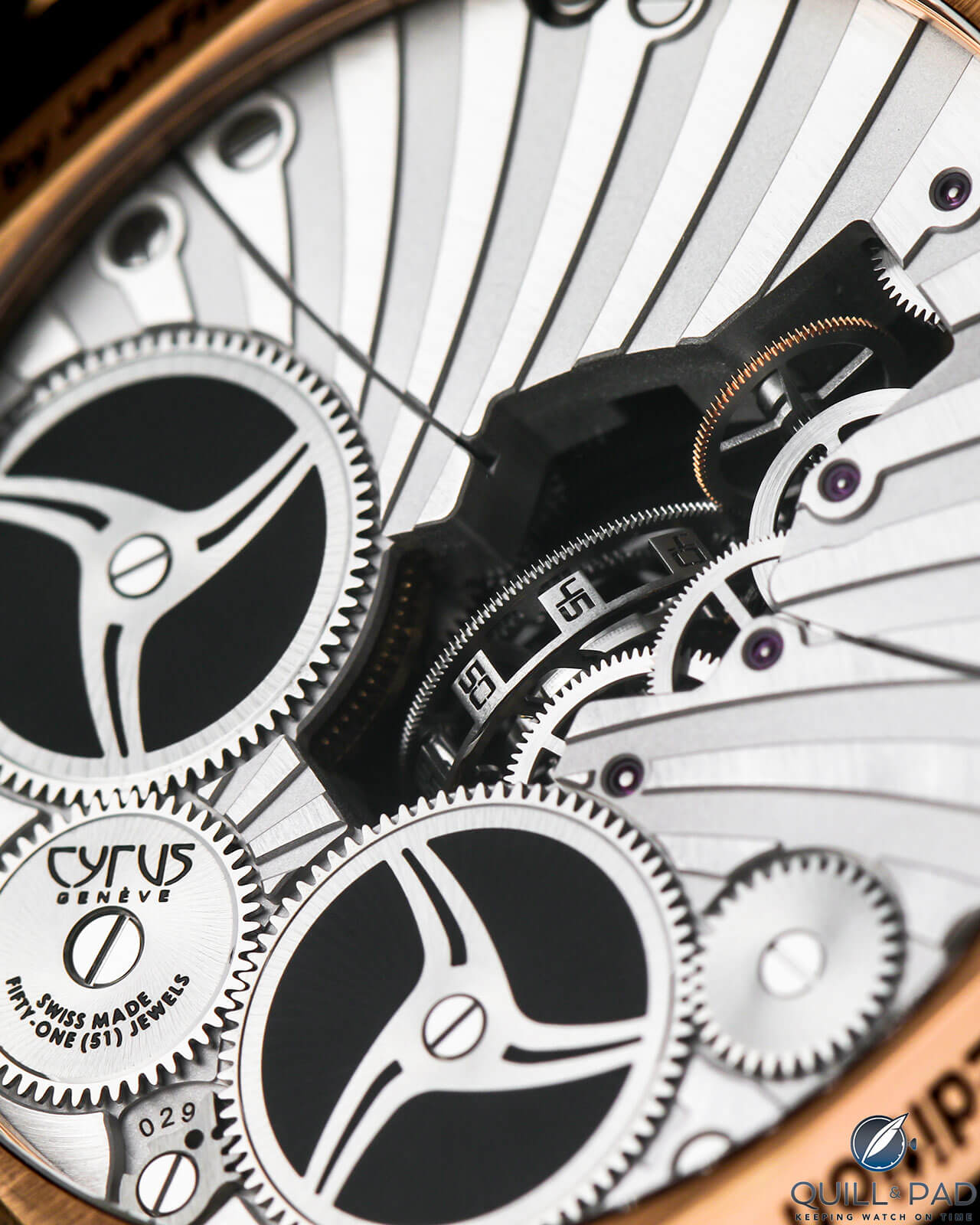
Cyrus Klepcys Vertical Tourbillon Skeleton movement detail
Of course, all that incredibly bold design comes at a cost and that is thickness. (I bet you thought I was going to say price!)
The watch is a fairly plump 18.65 mm (19.99 mm in the skeletonized version) in height thanks largely to the huge sapphire crystal dome covering the movement. The case itself is probably only half of the total thickness, but with a case diameter of 44 mm the watch feels sizeable on the wrist.
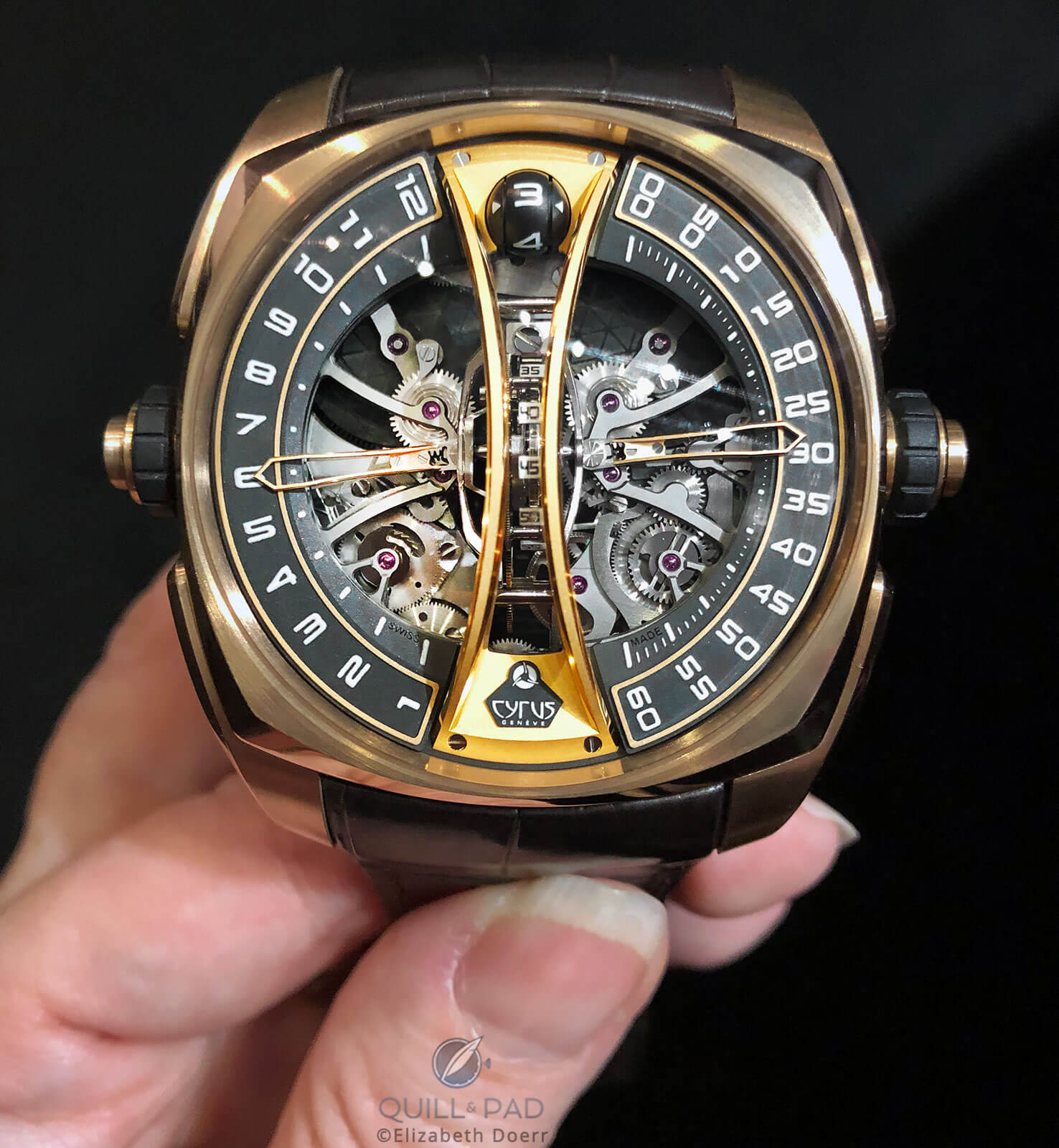
Cyrus Klepcys Vertical Tourbillon Skeleton
Thanks to the nearly integrated style of the lugs, it still wears very comfortably, but a stealthy watch this is not.
No matter the size, it still has a presence that is out of this world.
Many might be visually impressed by the Klepcys Vertical Tourbillon, but feel that large watches might be “too much watch” for them. Cyrus doesn’t need worry as the three launch variations are limited to 38 pieces each, while the skeleton models are extremely limited at just five pieces each.
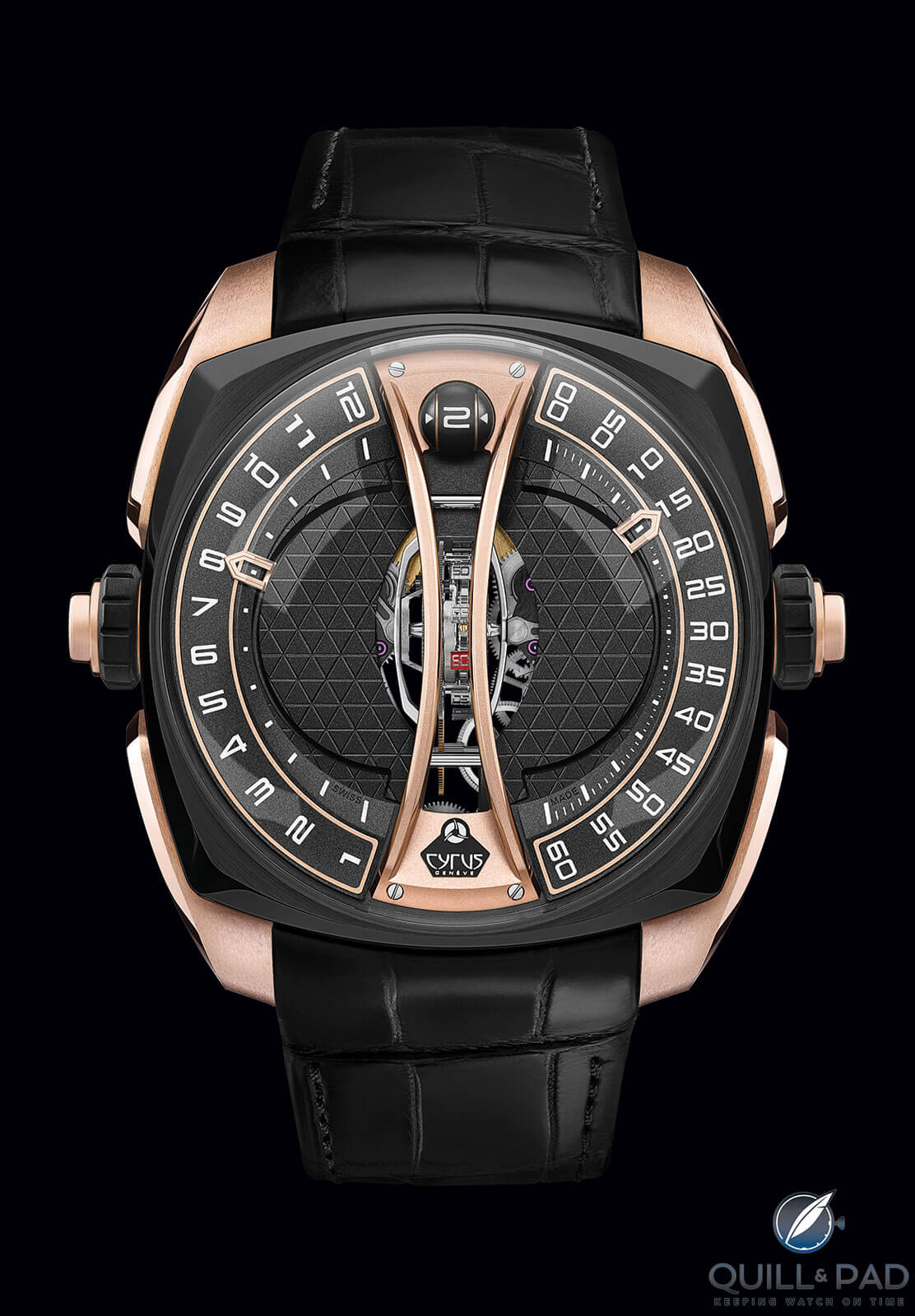
Cyrus Klepcys Vertical Tourbillon
I’m excited to appreciate these watches some more in the future and to see if the idea has any offshoots as well. I’m thinking an entire armada of interstellar spacecraft-themed pieces. What do you say, Cyrus?
While we travel the cosmos, let’s break the Klepcys Vertical Tourbillon down!
- Wowza Factor * 9.8 I mean, just look at that arch and the tourbillon! Plus, retrograde everything!
- Late Night Lust Appeal * 123» 1,206.218m/s2 When you are imagining life aboard a starship, you can stay up all night because it’s always night in space!
- M.G.R. * 69.9 The double retrograde with spherical power reserve and vertically oriented tourbillon movement made by Jean-François Mojon and his team at Chronode is easily a top-notch mechanical creation!
- Added-Functionitis * Mild Power reserves are awesome and should be on every watch (just saying), so this piece requires some children’s strength Gotta-HAVE-That cream for the single added function!
- Ouch Outline * 12.6 That moment you discover your back thinks it’s an old man . . . Aging happens, and that fun experience of a nearly seized up back reminds us that youth is wasted on the young. Or something like that. Still, if it meant getting this watch on my wrist I would definitely spend a few days laid up on the couch!
- Mermaid Moment * An arch to my heart! For some reason, the arch is a shape that hits me hard in my core, and it would definitely make me say “I’ll love you forever more!”
- Awesome Total * 932 First take the number of components in the movement (344) and multiply by the rate of the balance in Hz (3), and then subtract the number of hours in the power reserve (100) to get a boldly awesome total!
For more information, please visit www.cyrus-watches.ch/klepcys-vertical-tourbillon.
Quick Facts Cyrus Klepcys Vertical Tourbillon
Case: 44 x 18.65 mm, black DLC-coated titanium, red gold and black DLC-coated titanium, or red gold
Movement: manually-winding Caliber CYR625 with one-minute tourbillon, 3 Hz/21,600 vph frequency, 100-hour power reserve
Functions: retrograde jumping hours, retrograde minutes, seconds (on tourbillon); power reserve
Price: €105,000 (titanium), €118,000 (gold and titanium), €135,000 (gold)
Quick Facts Cyrus Klepcys Vertical Skeleton Tourbillon
Case: 44 x 19.99 mm, black DLC-coated titanium, red gold and black DLC-coated titanium, or red goldMovement: manually-winding Caliber CYR625 with one-minute tourbillon, 3 Hz/21,600 vph frequency, 100-hour power reserve
Functions: retrograde jumping hours, retrograde minutes, seconds (on tourbillon); power reserve
Price: €130,000 (titanium), €144,000 (gold and titanium), €164,000 (gold)
You may also enjoy:
Cyrus Klepcys Mars: Bringing Home The Red Planet
The Retrograde: One Of My Favorite Complications
Hermès Arceau L’Heure De La Lune: And Pegasus Flies On The Moon
The Harry Winston Opus Series: A Complete Overview From Opus 1 Through Opus 13



Leave a Reply
Want to join the discussion?Feel free to contribute!